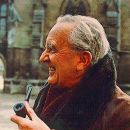![]()
![]()

The author of The Lord of the Rings is J.R.R. Tolkien. The initials stand for John Ronald Reuel- the last being a family name. As for Tolkien, it is a German name (the Professor is of German descent), and it is pronounced "Tul-KEEN" or "TOL-kin".
Although both his parents come from Birmingham, in northwestern Warwickshire, England, Tolkien himself was born, on January 3, 1892, in Bloemfontien, a city in the central portion of the Union of South Africa. He was extremely young when his father, Arthur Reuel Tolkien, died. His mother brought the children (Tolkien has a brother) back to her native city, and Tolkien was raised in Birmingham. He attended the King Edward VI School in that city, one of England's largest provincial municipalities, with a population of well over a million.
In 1904, when Tolkien was a boy of twelve, his
mother died. From that point on he and his brother were raised by
a Roman Catholic Priest. Tolkien went from King Edward's school
to Exeter College, Oxford, but before he could take his degree,
the First World War interrupted. At the age of twenty-three
Tolkien entered the Lancashire Fusiliers.
The following year, 1916, he married Miss Edith Bratt, who was
later to become the mother of his three sons and one daughter.
Tolkien served with the Fusiliers from 1915 until 1918. With the
collapse of Germany and the signing of the Armistice, he returned
home and went back to his college. He recieved his M.A. in 1919.
As a young man Tolkien fascinated by languages to such an unusual degree that he diverted himself with the inventions of new ones. After taking his degree, Tolkien worked for about two years as an assistant on the famous Oxford English Dictionary before beginning his career as a teacher. In 1920 he was a Reader in the English Language at the University of Leeds. His first major work of scholorship was published two years later; A Middle-English Vocabulary (1922). During the years 1924 and 1925 he was a Professor of English Language at Leeds. During this time he published, with E.V. Gordan, his critical text of Sir Gawain and the Green Knight , the famous fourteenth-century poem by an unknown contemporary of Chaucer.
In 1925 he left Leeds and came to Pembroke College at Oxford. For the next twenty years he remained there as Rawlinson and Bosforth Professor of Anglo-Saxon. By this time he found himself busily working out the sort of lands and countries in which his imaginary languages might be spoken, and before long he began making up stories about them. In 1926 Tolkien became a Fellow at Pembroke College. Many years later, he was to become an Emerson Fellow of Merton College, and also an Honorary Fellow of Exeter College which, of course, was his alma mater.
His years at Pembroke were fruitful. While teaching Anglo-Saxon, he published "Chaucer as a Philologist" (1934) and, two years later, "Beowulf: The Monster and the Critics," two influential papers. By this time he had become a highly regarded English philologist. Philology which, according to the dictionary, is the study of written records, the establishment of their authenticity and of their original form, and the determination of their meaning, is a branch of linguistics, of course; considering the fascination languages hold for Tolkien., it is a natural field for his endeavors.
Following his study of Beowulf came something quite different. In 1937, when Tolkien was forty-five years old, he published a little book for children called The Hobbit, or, There and Back Again.
The rest is more or less history!
Taken in part from "Tolkien:
A Look Behind the Lord of the Rings" By Lin Carter
Published by Ballentine Books, All Rights Reserved.
[Home]
[First Age]
[Second Age]
[Third Age]
[Maps] [Pictures] [The Author] [Webrings] [Links] [Guestbook] [Awards]